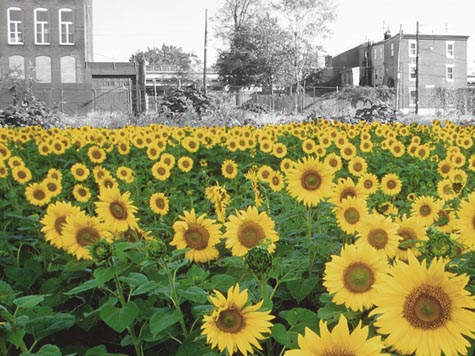 [Image: Front Studio. “Sunflowers aid in the bio-cleansing of land in preparation for crop farming”].
[Image: Front Studio. “Sunflowers aid in the bio-cleansing of land in preparation for crop farming”].
Last month, Front Studio architects gave a talk at the University of Pennsylvania Department of City & Regional Planning. There they outlined “Farmadelphia,” their now widely known proposal for the transformation of Philadelphia, in which that city’s vacant and abandoned lots are turned into a thriving agricultural zone – complete with crops grown for local consumption and soil remediation, and with an eye toward future tourism, including surreal petting zoos, hay rides, and even corn mazes.
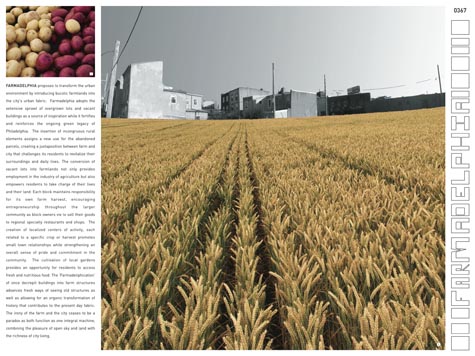 [Image: Front Studio].
[Image: Front Studio].
Philadelphia would become “an ‘edible landscape’,” we read, “with vast crop fields, and free roaming farm animals.”
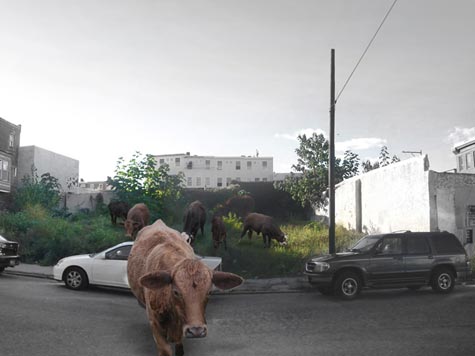
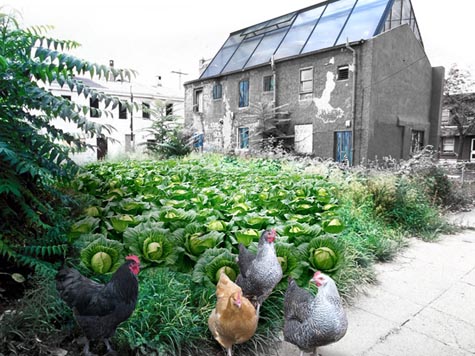 [Images: Front Studio. “Free roaming city cows graze on locally owned pasture” (top); chickens hang out amidst lettuce (bottom)].
[Images: Front Studio. “Free roaming city cows graze on locally owned pasture” (top); chickens hang out amidst lettuce (bottom)].
The project would also address – or is intended to address – “the rehabilitation of the existing city fabric by proposing ideas for vacant buildings that would allow the present-day character to remain while creating new uses.”
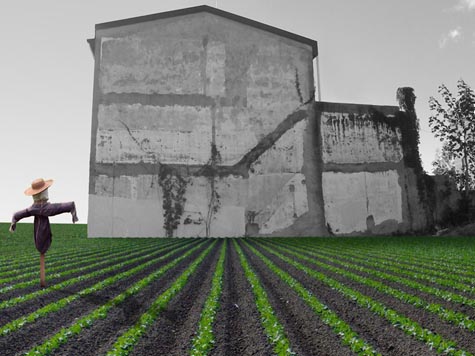 [Images: Front Studio].
[Images: Front Studio].
From the project description:
For example, an abandoned building could have its walls and ground lined with a non-permeable membrane to prevent soil contamination for new plantings. Then layers of a weed barrier, soil bed, loam and mulch are added on top. The nurseries would provide: year-round job opportunities, high profit yields from selling flowers and the adaptive reuse of abandoned buildings.
Whole sections of the city would thus be deliberately cultivated. Or, from a slightly different perspective, it’s the controlled re-wilding of the city.
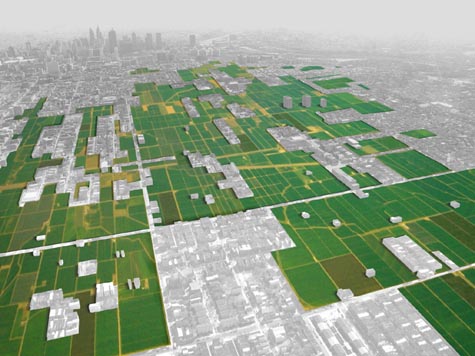 [Image: Front Studio. Philadelphia’s “urban voids interwoven with agricultural patchwork”].
[Image: Front Studio. Philadelphia’s “urban voids interwoven with agricultural patchwork”].
This urban re-wilding would also include “the rehabilitation of abandoned buildings into stables to house animals.”
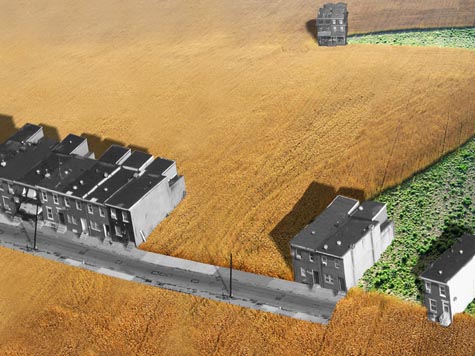 [Images: Front Studio].
[Images: Front Studio].
“Looking into Philadelphia’s past,” Front Studio writes, one finds “a green legacy dating back to William Penn’s pastoral vision of a ‘green countrie towne’.”
But what about Philadelphia’s green future – not its past or some distant legacy it’s passively inherited?
How might Philadelphia actively re-green itself for the future?
Some appropriate crops for the proposed agricultural stabilization of the city might include the following, the architects suggest:
—start with low maintenance, easy to grow, and profiting crops; consider perennial crops such as asparagus, shallots, garlic and herb varieties
—other crops include shade tolerant, easy to grow kale, sweet potatoes, lettuce
—other crops that do well in Philadelphia climate: collard greens, broccoli, mustard greens, corn, raspberry bushes
Those plants, in particular, would form a biosystem that could help push the city onto a seven year agricultural plan – after which this newly implanted ecosystem would level off, forming something like a cultivated permaculture.
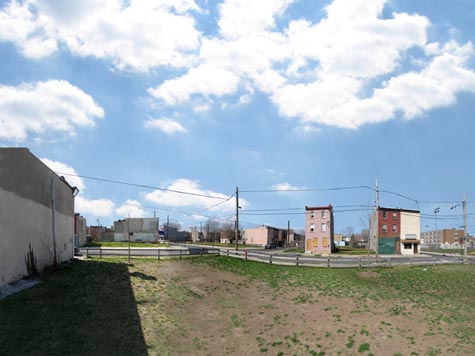
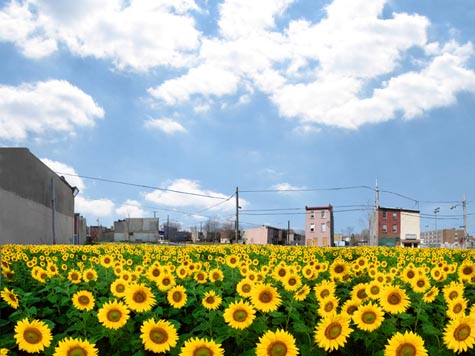
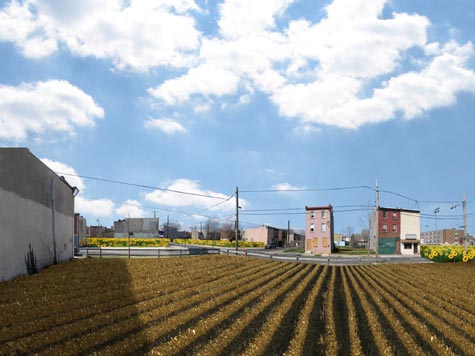
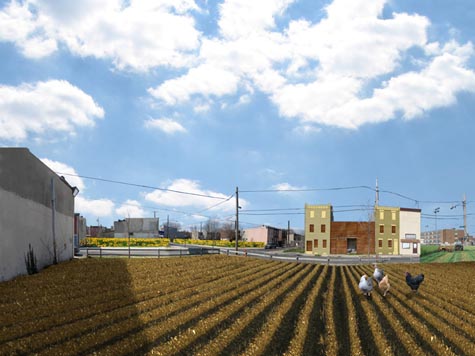
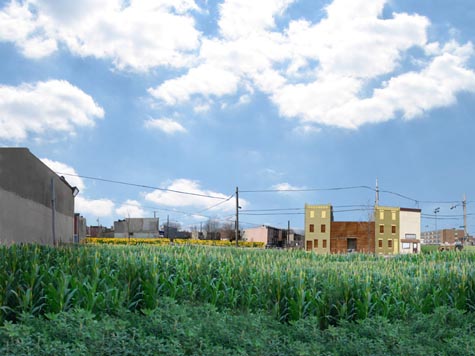 [Images: Front Studio‘s seven year plan for agricultural stabilization].
[Images: Front Studio‘s seven year plan for agricultural stabilization].
More about the project can be found on Front Studio’s own website (under “Work” and then “Competition”).
(See also Roof-farming southeast London, earlier on BLDGBLOG, as well as Going Agro.)
Great blog!
Also have a look at The Udder Way. In 2005 they started bringing cows into the declining city of liverpool. They had some very positive feedback from locals and the press. The project was also featured at the shrinking cities interventions exhibition.
Some great photos at the site…
I lived in the urban sprawl north of Tokyo for a year, and such was the pressure on land that a lot of it is like those pictures: apartment blocks interspersed with paddy fields, and vegetables growing in among residential buildings.
Especially, with the growth in awareness about food politics and the demand for local, sustainable food, i think it would be amazing to re-purpose our decayed and/or abandoned inner cities along these lines.
Not only could it help to restore the ecological diversity and health of such locales but it would also provide opportunities for job training and economic development..
Also take a look at the Shrinkingcities Project, specially here http://www.shrinkingcities.com/projekte3.0.html?&L=1
P.S. I would like to express all my appreciation on this uncommon architecture/urban blog reporting the translation of this post, according to the creative common license, on my space at http://www.elaboratorio05.it, an italian architecture blog.
(I’m sorry about the way I’ve comunicated my link but I wasn’t able to find your email address)
um, isn’t that why they blew up the MOVE house?
Small scale urban agriculture in inner city London:
A VACANT LOT- What if you make it accessible, add 70 big grow bags of soil, one water tower plus the participation and creativity of local residents?
Have a look under VACANT LOT: http://www.what-if.info
i live in west philadelphia, where there are already dozens of ‘abandoned’ lots in my immediate neighborhood that are being used for both small and large-scale gardening. they have it going on up in northern liberties, too. these were started up without the benefit of instructions from some blogger in his ivory tower. it seems that some things just aren’t brilliant ideas until some mouse-pusher who has never stepped out from his/her fluorescent office ‘imagines’ it.
Really amazing. Something similar happening in Buffalo, NY on the City’s near east side. Very well considered project that focuses on the integration of planning and sustainable urban issues. Learn more about the Queen City Farm.
This comment has been removed by the author.
This is an excellent idea. I think it would work even better in Detroit, which suffers much more acutely from high vacancy rates and a public image of being polluted.
My main worry, in whatever city this is located in, would be crime. Assuming the pictures of livestock wandering the streets are not facetious, they would be an obvious target 24/7, and crops that are edible raw (like most vegetables) would be extremely tempting right around harvest time.
Something similar is happening in exurban communities, where properties are being abandoned (or selling very cheaply) due to a glut of housing.
But in this case, the farming is being done inside the houses — and what’s being farmed is America’s largest cash crop.
While it’s a fantastic idea, what about all the pollution deposited in the soil from decades of automobiles and factory work?
Havana, Cuba actually has already done this to a large extent. When the Soviet Union collapsed, Cuba lost the main source of its oil, fertilizer, and grains. The entire nation had to very quickly switch from a sugar-plantation monoculture to an urban, food-producing permaculture in order to avoid famine – and by and large they’ve succeeded. I’ve read one source that claims that the country is now nearly food-independent and roughly 80% of its agriculture is organic.
So what Farmadelphia really needs to succeed is a Soviet Union type of agent to cut it off in the first place. How bout it, China?
pretty much totally unrelated, but speaking of farm/urban juxtaposition, have you ever seen Matthew Moore’s work? You may like.
fantastic idea. fantastic!
Yes – from my Philly days, I too remember seeing these fruitful vacant-lot gardens in Northern Liberties and one at Quince & Locust street, too. My back window used to look out on the Quince & Locust one.
I made a design project like this earlier this year in the U.K. with a design company called Zest Innovation and Debra at http://www.culiblog.org/.
1000 new ‘urban farmers’ grew food in neighborhood locations and vacant lots.
people turned their harvest in to delicious dishes at events called ‘kitchen playgrounds’.
the final harvest was enjoyed at a town meal event attended by over 6000 people and curated by artist Bob and Roberta Smith.
Finally, designers Andre Viljoen & Katrin Bohn created an ‘edible map’ of the town, showing a city transformed in to an edible landscape.
More at
http://www.dott07.com/go/food/urban-farming.
Image of the ‘edible map’ – well u can’t actually eat it…. – here
http://tinyurl.com/2x7sww
first off, i would like to say how much i enjoy your blog since i stumbled upon it back around april. also, as a subscriber to dwell magazine since its inception, i was happy to hear that you are now gainfully employed there (although i know it is a separate entity).
there was a book published in 2005 called “continuous productive urban landscapes: designing urban agriculture for sustainable cities” which was edited by andre viljoen. it was a series of essays explaining how this could be done (focusing on various UK cities). the content was very similar to what is described here. while i was doing my architecture undergraduate at IIT, i tried utilizing these principles in a studio project that was revitalizing a site in North Lawndale here in Chicago for a farmer’s market, training center, and community garden.
as for what a previous commentor (Rek) asked, with regards to what to do with contaminated soils: while i was at IIT, i did a summer class/project that turned a vacant lot on chicago’s southside right along the dan ryan expressway into a community garden using plants that are excellent phytoremediators. there are various plants such as sunflowers that really suck various pollutants such as lead and mercury out of the soil. some of the plants store the chemicals in their leaves, some in their fruit, and others make them airborne by respirating them out into the air. the EPA even has a brownfield remediation program that emphasizes using this, although the most common practice still is to come to the site, dig up all the soil to a certain depth, truck it off-site and burn the soil (once again, making the pollutants airborne).
on chicago’s south and west sides, this is definitely something i would like to see happen, although gentrification is much more likely to happen. the property assessments just came out here, and some of the poorest neighborhoods are being hit the hardest because the developers have already started to come in and buy up the land dirt cheap and drop in houses that look like they were airlifted from the suburbs to turn quick profits.
also, as a final part to my extremely long comment, is for anyone interested in this should try to check out alfred caldwell and ludwig hilbersreimer’s work from the 1950’s. alfred caldwell worked with jens jensen, frank lloyd wright, and mies van der rohe at various points throughout his career. he was recruited by mies, hilbersreimer (the city and regional planning theorist mies brought over from germany) and walter peterhans (the visual training professor mies brought with as well) to teach at IIT and help re-shape the curriculum. caldwell and hilbersreimer had various city planning proposals that touched on ideas like this.
I can see how this appeals to many current cultural trends (greening urban space, locally grown food, etc) but I can’t for the life of me fathom how this can be seen as “sustainable” or eco-friendly. I am not saying a city must be wall to wall density but I thought we’ve finally awakened to the many pitfalls of sprawl and by inhibiting density (infill) this can only contribute to it. I’m all for a farm here and there, but I get an uneasy when I see people talking about this is a re-development model for vast areas of urban decay.
I am not opposed to urban agriculture, but I am worried about how it is presented here. This is almost all image and no substance, with little input from the existing farming community or the residents of the affected communities. Do poor Philadelphians want to farm? Do they have the necessary resources? Who will teach them?
And do these farm areas work as shown? Are they economically sustainable? It is disturbing that the aerial image suggests urban islands in the midst of farms. Could closing all of those streets lead to even more decline in the city? And can cows free graze in an urban environment? They, at the least, will need herders. And the farm plots themselves will need protection. Even unintentional harm can result from a big footed person walking through during plowing time.
Most of this critique stems from a simple omission: None of the images show people. We seem to have forgotten that these are still ‘urban’ neighborhoods full of a variety of uses, some of which are incompatible with farming. How do markets, offices, playgrounds, schools, vehicular traffic, parking areas, waste management (both urban and farm), etc. function in these environments?
Adaptive re-use is a good thing, but beautiful imagery without the back-up of solid research confuses this discussion. It seems that we cannot proceed without some input from successful commercial farmers and from the targeted communities. I hope that future work will proceed accordingly.
Having lived in Philadelphia for the past two years I have a hard time buying into “Farmadelphia” working on such a large scale. First of all much of the soil is contaminated from Philadelphia’s industrial past and also how would irrigation work? The Schuylkill is much too polluted to be a viable source, and what about runoff from fertilization? Farming is not the most eco-friendly solution either. There are too many questions brought up by this so called solution to the abandoned sites in Philadelphia. Philly needs to focus on its plans to move I-95 to reconnect the city to the Delaware river which was once its economic lifeline and create a more appealing riverside rather than the current view of the interstate. This whole “farmadelphia” idea is too far fetched to be realized on a large scale. besides, does anyone find these renderings that appealing anyway?
Green walls and roofs are also a great venue in which to encourage urban agriculture in densely populated areas. To learn more about design and implementation please visit our website at
http://www.greenroofs.org/baltimore
We also have an international conference coming up in Baltimore during the last week of April with international experts!!
Very nice images. Brings me back memories of my past there.